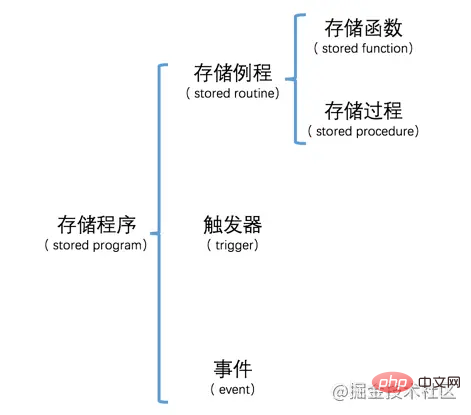
This article brings you relevant knowledge about custom variables and statement end delimiters in mysql. I hope it will be helpful to you.

Sometimes in order to complete a common function, you need to execute many statements, and each time you enter these statements one by one in the client. Multiple statements are annoying. The uncle who designed MySQL very thoughtfully provided us with something called stored program. This so-called stored program can encapsulate some statements. Then provide the user with a simple way to call this stored procedure to execute these statements indirectly. Depending on the calling method, we can divide stored procedures into the following types: stored routines, triggers and events. Among them, Stored routines can be subdivided into Stored functions and Stored procedures. Let’s draw a picture to show it:

Don’t be afraid that there are many unfamiliar concepts, we will break them down later. However, before formally introducing stored procedures, we need to first understand the concepts of custom variables and statement end delimiters in MySQL.
In life we often encounter some fixed values, such as numbers 100, strings 'Hello' , we call these things with fixed values constants. But sometimes for convenience, we will use a certain symbol to represent a value, and the value it represents can change. For example, we stipulate that the symbol a represents the number 1, and then we can let the symbol a represent the number 2. We can make this value happen The changed stuff is called variable, and the symbol a is called the variable name of this variable. In MySQL, we can customize some of our own variables through the SET statement, for example:
mysql> SET @a = 1; Query OK, 0 rows affected (0.00 sec) mysql>
The above statement indicates that we have defined a name It is a variable of a, and the integer 1 is assigned to this variable. However, everyone needs to pay attention to the fact that the uncle who designed MySQL stipulated that we must add a @ symbol in front of our custom variables (although it is a bit strange, this is what others stipulated, so everyone should just abide by it).
If we want to check the value of this variable later, just use the SELECT statement, but we still need to add a @ symbol before the variable name:
mysql> SELECT @a; +------+ | @a | +------+ | 1 | +------+ 1 row in set (0.00 sec) mysql>
The same variable can also store different types of values. For example, we assign a string value to the variable a:
mysql> SET @a = '哈哈哈'; Query OK, 0 rows affected (0.01 sec) mysql> SELECT @a; +-----------+ | @a | +-----------+ | 哈哈哈 | +-----------+ 1 row in set (0.00 sec) mysql>
In addition to assigning a constant to a In addition to variables, we can also assign one variable to another variable:
mysql> SET @b = @a; Query OK, 0 rows affected (0.00 sec) mysql> select @b; +-----------+ | @b | +-----------+ | 哈哈哈 | +-----------+ 1 row in set (0.00 sec) mysql>
In this way, variables a and b will have the same value'Wahaha' !
We can also assign the result of a certain query to a variable, provided that the result of the query has only one value:
mysql> SET @a = (SELECT m1 FROM t1 LIMIT 1); Query OK, 0 rows affected (0.00 sec) mysql>
We can also use another form of statement to assign the query result The result is assigned to a variable:
mysql> SELECT n1 FROM t1 LIMIT 1 INTO @b; Query OK, 1 row affected (0.00 sec) mysql>
Because the query results of the statements SELECT m1 FROM t1 LIMIT 1 and SELECT n1 FROM t1 LIMIT 1 have only one value, so they It can be directly assigned to variable a or b. Let’s check the values of these two variables:
mysql> SELECT @a, @b; +------+------+ | @a | @b | +------+------+ | 1 | a | +------+------+ 1 row in set (0.00 sec) mysql>
If our query result is a record with multiple column values in the record, we want to assign these values to different variables. , only the INTO statement can be used:
mysql> SELECT m1, n1 FROM t1 LIMIT 1 INTO @a, @b; Query OK, 1 row affected (0.00 sec) mysql>
The result set of this query statement only contains one record, we put the value of the m1 column of this record The value is assigned to variable a, and the value of column n1 is assigned to variable b.
At the interactive interface of the MySQL client, when we complete the keyboard input and press the Enter key, MySQL The client will detect whether the content we input contains one of the three symbols ;, \g or \G. If so, it will input us. content is sent to the server. In this way, if we want to send multiple statements to the server at once, we need to write these statements in one line, such as this:
mysql> SELECT * FROM t1 LIMIT 1;SELECT * FROM t2 LIMIT 1;SELECT * FROM t3 LIMIT 1; +------+------+ | m1 | n1 | +------+------+ | 1 | a | +------+------+ 1 row in set (0.00 sec) +------+------+ | m2 | n2 | +------+------+ | 2 | b | +------+------+ 1 row in set (0.00 sec) +------+------+ | m3 | n3 | +------+------+ | 3 | c | +------+------+ 1 row in set (0.00 sec) mysql>
The reason for this inconvenience is that, MySQLThe symbol used by the client to detect the end of input is the same as the symbol that separates each statement! In fact, we can also use the delimiter command to customize the symbol at the end of the MySQL detection statement input, which is the so-called statement end delimiter , such as this:
mysql> delimiter $ mysql> SELECT * FROM t1 LIMIT 1; -> SELECT * FROM t2 LIMIT 1; -> SELECT * FROM t3 LIMIT 1; -> $ +------+------+ | m1 | n1 | +------+------+ | 1 | a | +------+------+ 1 row in set (0.00 sec) +------+------+ | m2 | n2 | +------+------+ | 2 | b | +------+------+ 1 row in set (0.00 sec) +------+------+ | m3 | n3 | +------+------+ | 3 | c | +------+------+ 1 row in set (0.00 sec) mysql>
delimiter $命令意味着修改语句结束分隔符为$,也就是说之后MySQL客户端检测用户语句输入结束的符号为$。上边例子中我们虽然连续输入了3个以分号;结尾的查询语句并且按了回车键,但是输入的内容并没有被提交,直到敲下$符号并回车,MySQL客户端才会将我们输入的内容提交到服务器,此时我们输入的内容里已经包含了3个独立的查询语句了,所以返回了3个结果集。
我们也可以将语句结束分隔符重新定义为$以外的其他包含单个或多个字符的字符串,比方说这样:
mysql> delimiter EOF mysql> SELECT * FROM t1 LIMIT 1; -> SELECT * FROM t2 LIMIT 1; -> SELECT * FROM t3 LIMIT 1; -> EOF +------+------+ | m1 | n1 | +------+------+ | 1 | a | +------+------+ 1 row in set (0.00 sec) +------+------+ | m2 | n2 | +------+------+ | 2 | b | +------+------+ 1 row in set (0.00 sec) +------+------+ | m3 | n3 | +------+------+ | 3 | c | +------+------+ 1 row in set (0.00 sec) mysql>
我们这里采用了EOF作为MySQL客户端检测输入结束的符号,是不是很easy啊!当然,这个只是为了方便我们一次性输入多个语句,在输入完成之后最好还是改回我们常用的分号;吧:
mysql> delimiter ;
小贴士: 我们应该避免使用反斜杠(\)字符作为语句结束分隔符,因为这是MySQL的转义字符。
推荐学习:mysql视频教程
The above is the detailed content of Let's talk about the basics of MySQL custom variables and statement end delimiters. For more information, please follow other related articles on the PHP Chinese website!